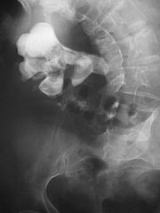
Kidney stone
Overview
A kidney stone, also known as a renal calculus (from the Latin
ren, "kidney" and calculus
, "pebble") is a solid concretion
or crystal
aggregation formed in the kidneys from dietary mineral
s in the urine
. Urinary stones
are typically classified by their location in the kidney
(nephrolithiasis), ureter
(ureterolithiasis), or bladder
(cystolithiasis), or by their chemical composition (calcium
-containing, struvite
, uric acid
, or other compounds).
Latin
Latin is an Italic language originally spoken in Latium and Ancient Rome. It, along with most European languages, is a descendant of the ancient Proto-Indo-European language. Although it is considered a dead language, a number of scholars and members of the Christian clergy speak it fluently, and...
ren, "kidney" and calculus
Calculus (medicine)
A calculus is a stone that forms in an organ or duct of the body. Formation of calculi is known as lithiasis...
, "pebble") is a solid concretion
Enterolith
An enterolith is a mineral concretion or calculus formed anywhere in the gastrointestinal system. Enteroliths are uncommon and usually incidental findings but, once found, they require at a minimum watchful waiting...
or crystal
Crystal
A crystal or crystalline solid is a solid material whose constituent atoms, molecules, or ions are arranged in an orderly repeating pattern extending in all three spatial dimensions. The scientific study of crystals and crystal formation is known as crystallography...
aggregation formed in the kidneys from dietary mineral
Dietary mineral
Dietary minerals are the chemical elements required by living organisms, other than the four elements carbon, hydrogen, nitrogen, and oxygen present in common organic molecules. Examples of mineral elements include calcium, magnesium, potassium, sodium, zinc, and iodine...
s in the urine
Urine
Urine is a typically sterile liquid by-product of the body that is secreted by the kidneys through a process called urination and excreted through the urethra. Cellular metabolism generates numerous by-products, many rich in nitrogen, that require elimination from the bloodstream...
. Urinary stones
Urolithiasis
A bladder stone is a solid concretion or crystal aggregation found in the urinary bladder...
are typically classified by their location in the kidney
Kidney
The kidneys, organs with several functions, serve essential regulatory roles in most animals, including vertebrates and some invertebrates. They are essential in the urinary system and also serve homeostatic functions such as the regulation of electrolytes, maintenance of acid–base balance, and...
(nephrolithiasis), ureter
Ureter
In human anatomy, the ureters are muscular tubes that propel urine from the kidneys to the urinary bladder. In the adult, the ureters are usually long and ~3-4 mm in diameter....
(ureterolithiasis), or bladder
Urinary bladder
The urinary bladder is the organ that collects urine excreted by the kidneys before disposal by urination. A hollow muscular, and distensible organ, the bladder sits on the pelvic floor...
(cystolithiasis), or by their chemical composition (calcium
Calcium
Calcium is the chemical element with the symbol Ca and atomic number 20. It has an atomic mass of 40.078 amu. Calcium is a soft gray alkaline earth metal, and is the fifth-most-abundant element by mass in the Earth's crust...
-containing, struvite
Struvite
Struvite is a phosphate mineral with formula: NH4MgPO4·6H2O. Struvite crystallizes in the orthorhombic system as white to yellowish or brownish-white pyramidal crystals or in platey mica-like forms. It is a soft mineral with Mohs hardness of 1.5 to 2 and has a low specific gravity of 1.7...
, uric acid
Uric acid
Uric acid is a heterocyclic compound of carbon, nitrogen, oxygen, and hydrogen with the formula C5H4N4O3. It forms ions and salts known as urates and acid urates such as ammonium acid urate. Uric acid is created when the body breaks down purine nucleotides. High blood concentrations of uric acid...
, or other compounds).

